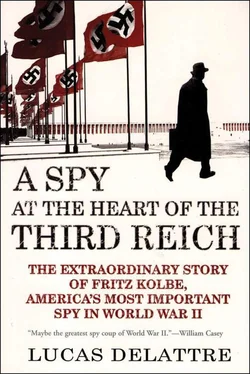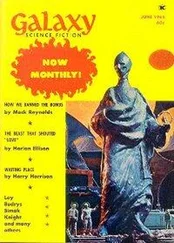On several occasions, Fritz asked for help from another of his acquaintances, Wilhelm Mackeben, who lived in a chalet in Bavaria, in the Allgäu region near Lake Constance. Mackeben traveled extensively around Europe as an “independent sales representative.” He was a former Foreign Ministry official, politically conservative but very opposed to the Nazis. After some service in Latin America, he found himself working for Karl Ritter beginning in September 1939. It was there that Fritz had met him. But the NSDAP had finally gotten his head in 1942, when he had been forced to leave the ministry. During the spring of 1944, Mackeben agreed to get Fritz’s mail to Switzerland. Apparently he still enjoyed a special status that allowed him to go through customs without being checked. He did not know what he was carrying. In any event, Fritz trusted him enough to give him Ernst Kocherthaler’s address. Mackeben was delighted to meet him because he was a “useful contact,” with connections in many parts of Europe. On the way there, Fritz’s messages were hidden in the lining of a piece of clothing or the sole of a shoe. On the way back, the Americans’ answers were concealed in packages of coffee, cigars, or cigarettes.
The first time that Mackeben went back and forth between Berlin and Bern was in May 1944. A letter from Fritz dated May 10 reached Dulles through him. In this letter, Fritz provided a list of the principal spies working for Germany in North Africa (Tangiers, Tetouan, Casablanca). It contained the names of several diplomats, members of consular services, and journalists of every nationality (including Frenchmen, Italians, and even a former Norwegian consul). The letter contained more than just information. Fritz for the first time expressed irritation. He asked why the Americans had still not followed his advice and bombed, for example, a Siemens capacitor factory in Gera (Thuringia), the petrochemical factories of Leuna, or a communications center of the Navy command in Eberswalde (northeast of Berlin). He was also surprised to learn that nothing had been done to interrupt the flow of tungsten from Spain to Germany (“Wood comments cable speaks for itself and adds: ‘are you still asleep?’”).
“If you are satisfied with me, send me some Nescafé. If you no longer want me to send you information, send me a pair of scissors,” Fritz had added, clearly sulking a little, no longer sure whether the Americans still needed him. “If you have things to ask me, send me cigarettes and put something in them please, because I’ll smoke them myself,” he added in one of the coded messages he liked to use. The letter ended with these words: “I will not fail to seize any coming opportunity to write to you, even if I have to set to work in the early morning hours after an air raid. Sorry for my disjointed writing. I’m so overwhelmed that I no longer know what I’m doing. My fiancée complains that I am neglecting her. And yet I love her!”
The Americans’ answer, slipped into a package of cigarettes, tried to be reassuring: “Try to come to see your former father-in-law in Zurich. Find a pretext connected with the settling of your divorce.” But Fritz did not receive the message. In late May, when Mackeben was getting ready to return to Germany with the “cigarettes” intended for Fritz, Ernst Kocherthaler received a terse telegram from Berlin: “Please no cigarettes,” signed “Georg.”
Berlin, May 31, 1944
There was a meeting that evening in Berlin of the Wednesday Club at Sauerbruch’s. The Grunewald neighborhood was half in ruins, but Sauerbruch’s house on Herthastrasse was still standing. The speaker was General Beck, who was delivering a presentation on Marshal Foch,
“our great French adversary,” whom he was honored to have known personally. Despite his reservations about the Versailles treaty and “the mistakes of French policy in the Rhineland after 1918,” General Beck delivered a very laudatory speech about the old adversary of the armies of von Klück and Moltke. Of course, he said in substance, Foch can be criticized for having been impulsive, stubborn, and sometimes a little rigid in his approach to the offensive. But Beck was full of admiration for this man, who had always acted within the limits of what was possible and whom he described in conclusion as “a great man and a great general.” The applause was warm. Then the eight guests went to the table and the conversation quickly changed to other subjects. “Sauerbruch always serves sparkling wine. And since we never have much in our stomachs, the atmosphere soon gets lively,” in the words of one of the people present that evening, the philosopher Eduard Spranger.
Some members of the Wednesday Club knew that General Beck was involved with a group of conspirators who intended to eliminate Hitler, overthrow the Nazi regime, and negotiate a separate peace with the Western powers. If the plan were to succeed, Ludwig Beck was supposed to become head of state in place of the führer. Ulrich von Hassell, who was also at Sauerbruch’s that evening, was the prospective foreign minister. It was here in Ferdinand Sauerbruch’s house that Ludwig Beck had met for the first time a young and brilliant officer who was supposed to become secretary of state in a future ministry of war after the coup d’état: Colonel von Stauffenberg, chief of staff of the Army Supply Services. Count von Stauffenberg had been treated in Munich by Professor Sauerbruch for serious wounds suffered in Africa. Struck by a mine explosion, he had lost an eye, his right hand, and two fingers of his left hand. Stauffenberg did not take part in the meetings of the Wednesday Club. But most of its members knew him well and knew that he represented, along with Carl Goerdeler (future chancellor in the event the coup was successful), a central element in the resistance to the regime.
Through the intermediary of their friend Hans-Bernd Gisevius in Switzerland, General Beck and Carl Goerdeler had sent several messages to Allen Dulles, in early April and early May 1944. In the name of their resistance organization, which included dozens of high-ranking officers and various political figures, conservatives, and old Social Democrats, these men were asking for help from the United States in case their coup were to succeed. They proposed to the Americans the capitulation of the Wehrmacht on condition that they be able to continue the war in the East against the Soviets. They were in favor of a massive landing of Western troops in Germany and asked particularly that several American airborne divisions be parachuted into Berlin. But Dulles’s reply had not been encouraging: “My orders are clear: the surrender of Germany will be unconditional and nothing can be done without the Soviets,” he had told them in substance.
The plot was nevertheless closely followed by the Americans. While the British refused to accept the very idea of a “German resistance,” Dulles transmitted to his superiors the names of the principal conspirators and the contents of their plans. He had for a long time now been in contact with another member of the conspiracy, who was also calling in vain for Allied help in overthrowing Hitler: the diplomat Adam von Trott zu Solz, who had gone to Bern several times in the course of 1943 and in early 1944. In the language of the OSS, the conspirators had become Breakers, General Beck was Tucky, Goerdeler was Lester, and Adam von Trott was 800 .
Berlin, June–July 1944
Life in Berlin was more and more dangerous for Fritz. In late June, he sent another message to Bern in which he confessed: “The last few days have been very difficult for me. Suspicions seemed to be weighing on me, but then they seem to have been dissipated. In any case, I have heard nothing further.” He nevertheless continued to provide information. The quality of the “material” did not decline; quite the contrary. In late June 1944, he revealed that “the Germans are still expecting a landing in the Pas-de-Calais, even after 6 June, and are not withdrawing troops from the Belgian coast for that reason.” In early July, he provided a series of details on the V-1s and future V-2s: “The flight control mechanism is produced in Gdynia, at the Ascania works, on the Baltic (near Danzig). The jets are built by Krupp in Wuppertal, additional parts which are not named are manufactured by the Siemens factories north of Augsburg…. Both the V-1 and V-2 models are made in the lower Danube region, in the vicinity of St. Valentin.” Other electronic equipment intended for the V-2 is manufactured “in the Siemens factory in Arnstadt, in Thuringia, about forty-five kilometers west of Orlamünde.” “In comparison with the V-1, the V-2 travels through the stratosphere. It is radio controlled and therefore a more accurate weapon. In addition, it possesses a longer range. This new model will be in use by the Nazis within 60 days at the outside.”
Читать дальше











